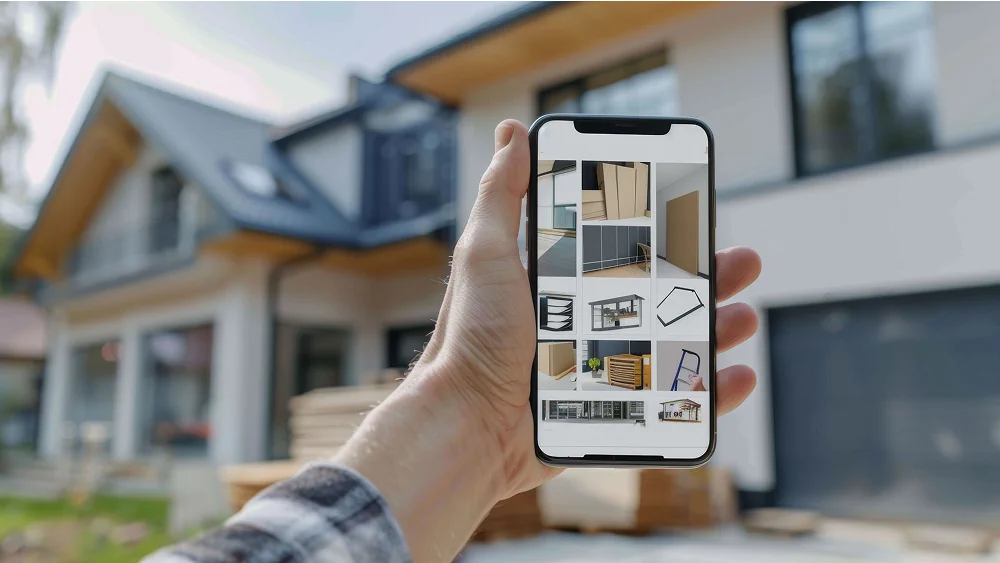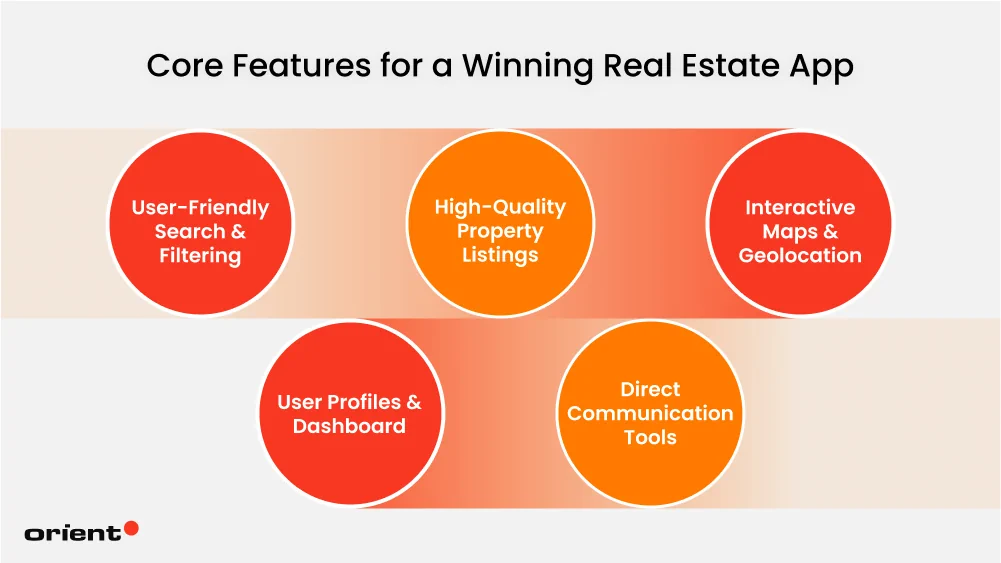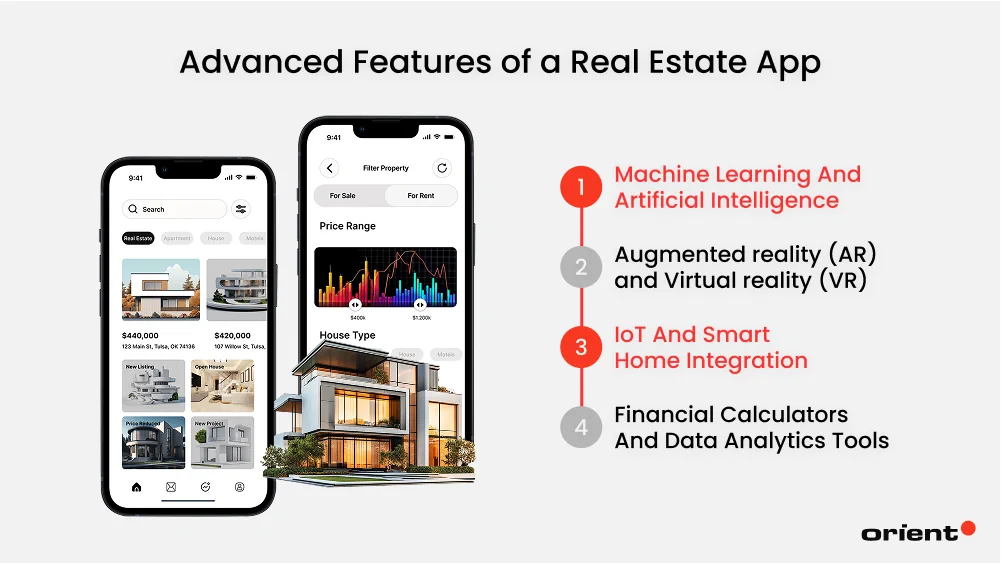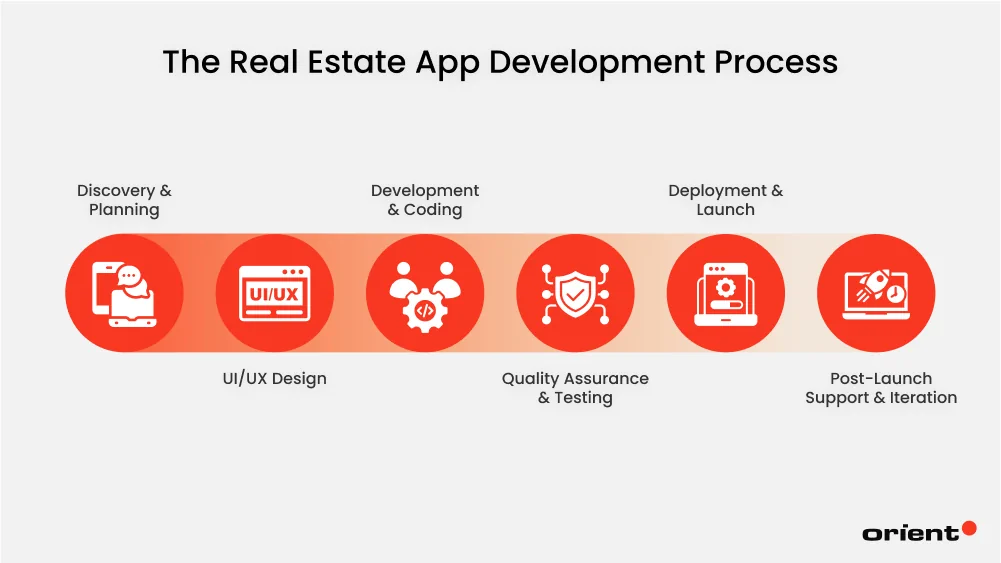The real estate industry has experienced a tremendous digital transition as real estate mobile applications are emerging as the focal point of buying, selling, and managing property. Whereas back in 2013, most real estate agents continued to use traditional listings and physical tours, by 2024, various apps such as Zillow and Redfin had millions of active users. The use of virtual property tours, advanced search filters, and real estate guidance based on artificial intelligence, among other characteristics, has become an ordinary thing, and the development of the mobile application has now become an essential component of the contemporary real estate company.
However, it also means the market is becoming incredibly crowded and competitive, a personal real estate application should be more than just a property listing advertisement. To not only survive but to truly “win” the market, you need a strategic approach that moves beyond basic features and leverages cutting-edge technology to solve real user problems.
Here we will guide you through the intricate process of building a successful real estate app from the ground up. We consider the fundamentals of real estate app development, including who you are targeting, creating a real estate site with the essential functions and innovative technology to keep you ahead of the curve in 2025, and beyond.
The Evolving Landscape of Real Estate Apps
The real estate sector is rapidly shifting online, with real estate mobile applications becoming the go-to platforms for property buyers, sellers, and agents. Market Growth Reports projects the global real estate app market will hit $18 billion by 2025, fueled by demand for smarter, more immersive solutions. Already, 72% of properties are searched online, and over 88 million users in Asia-Pacific alone rely on real estate apps to browse housing, check property listings, and even take virtual property tours directly on mobile devices. At the same time, property management apps are experiencing explosive growth, expected to climb from $3.2 billion in 2023 to $7.8 billion by 2033.
In today’s competitive real estate industry, winning real estate apps stand out by integrating AI-powered property recommendations, predictive pricing, and AR/VR-driven virtual tours that enhance engagement. With strong real estate app design and user-friendly features, developers can boost agent productivity, simplify real estate transactions, and bring transparency to the real estate market. Even small teams and startups can thrive in this space by defining a clear target audience, leveraging proven mobile app development strategies, and building real estate platforms that create lasting value.
Understanding Your Niche: The First Step to Victory
The market has too many players in the real estate application business, and it is not an easy one to break into. The key toward winning the market competition is to be aware of your niche, and that starts with really digging into who it is an app should be built for and what the competition is doing, but more importantly, what you do offer in your app that truly makes it unique.

Identifying Target Audience
Getting specific about your target audience is the first thing to do. Successful apps target a specific segment of customers with a specific need and do not aim at appealing to the masses.
This may involve property buyers looking to invest in affordable homes, real estate investors interested in business premises applications, the property owners who are looking to get high traffic on their property listings, renters looking at avenues with flexibility, or the real estate agents and property managers who need property management and client interaction applications.
The challenges facing each group are unique, and therefore, the key to the development of real estate apps lies in the determination of the pain points.
Market Research & Competitor Analysis
After identifying your audience, you need to conduct sufficient background research on the current market. Your competitors are not just Zillow or Redfin: they are digital tools your target audience would use in solving their problem in any way possible.
Carry out a full competitor analysis to be aware of their strengths and weaknesses. What characteristics do they have? How do they price? What do the customers say about the usability of their own app?
In the case of a property management app, you would examine such apps as DoorLoop or TenantCloud to understand what options and functions they offer and what the issues people complain about are, whether it is sluggish or has insufficient customer service.
By conducting this research, you will be able to know the market gaps or where the existing solution might fail so that you can seize the opportunity and come up with a better product.
Choosing Your Types of Real Estate Mobile Apps
Real estate applications are wide-ranging, and knowing the various categories of applications will enable you to determine your niche.
- Property Listing & Marketplace Apps: These are the most prevalent, which are aimed at matching buyers, sellers, and renters with the properties. They are usually characterized by their extensive databases and extensive search filters.
- Property Management Apps: These apps are aimed at the landlord and property managers to make their work effectively organized by facilitating rent collection, maintenance needs tracking, and communication with tenants. An example would be an app that would enable a landlord to approve a maintenance request and pay a contractor directly using the phone.
- Real Estate Investment Apps: These applications are useful to advanced investors because they offer market analysis tools, property valuation software, deal sourcing, and portfolio management. They could provide such functions as the possibility to crowdfund real estate projects or elaborate ROI calculators.
- Agent & Brokerage Apps: Designed to assist real estate professionals, these applications provide customer relationship management (CRM) software, lead generation services, and marketing automation tools to make real estate agents more efficient in their businesses.
- Niche-Specific Apps: Here, you can be the real differentiator. These can be commercial real estate apps, vacation rental apps, foreclosure and auction apps, or apps dedicated to luxury properties or green-certified homes.
Considering a certain type of app, you can develop the product that will not be merely an imitation of some widely popular marketplace but a highly functional, specialized solution that will perfectly satisfy the demands of the target audience.
Defining a Unique Value Proposition (UVP)
A UVP is one simple, straightforward message that tells your target users the thing about your app that makes it a better choice than your competitors. It is not just a slogan, it is an avowal of certain advantages. When you want to define your UVP, you have to merge your knowledge of what your target audience is feeling or has a pain point with what you learned during your competitor analysis.
Core questions your UVP needs to answer are:
- What is the pain point that you are helping to solve? (e.g., “It is hard to find a home with particular green features.”)
- How do you fix it? (e.g., we have the largest repository of greenhouses with certified sustainability ratings.)
- What are you unique in? (e.g., “Our platform is the only one that utilizes AI to validate the sustainability claims of a property and offers transparent cost projections of utility expenses.”)
A good UVP might be: “We make sustainable, eco-friendly homes easy to find, helping eco-savvy buyers find the home of their dreams through real-time AI-verified sustainability scores, as well as clear back-end utility information, not available on any other web portal.” This is very focused and advantage-driven, and it also sets a clear distinction between your app and the competition, which forms the base of an effective market idea.
Core Features for a Winning Real Estate App
The main features that every successful real estate mobile app should have are located at the very core and make the process of home-buying as simple as possible but still guarantee the feeling of security and interest.

User-Friendly Search & Filtering
They must have the possibility to use sophisticated filters that apply to their particular way of life, among which are the number of bedrooms, square footage, kind of property (e.g., house, condo, townhouse), and amenities (e.g., swimming pool, garage, pet-friendliness). The most important feature is the possibility of saving the search so that a user would be able to retrieve his or her favorite parameters rather easily, without refilling the boxes every time he or she wants to get back. This saves time and enables the app to alert users when new properties that fall into their line of interest are added.
High-Quality Property Listings
Apps need to do more than a few low-resolution pictures. The successful tools include adding high-resolution images and well-developed descriptions of the property that should be updated regularly. To provide a virtually engaging experience that can save the necessity of a physical visit to a great extent, you need to add video walkthroughs and 3D/VR tours. These amenities enable one to virtually explore the layout of a property and have a real feel of the space in the comfort of their living room. A floor plan or a list of appliances may also be of great value if some unique features of properties are mentioned.
Interactive Maps & Geolocation
The non-negotiable feature is an interactive map that anchors the user experience. Using such geolocation services as Google Maps or Mapbox, the app must be capable of showing properties on the map relative to the current position of the user or a specified space. In addition to displaying property locations, a robust app delivers detailed neighborhood information, points of interest (POIs) such as schools, parks, and grocery stores, and public transportation. This context enables users to know how convenient and how they will live life in a place before a viewing, hence, their relocation decision-making process will be better informed and efficient.
User Profiles & Dashboard
It is desirable that the users can create an account to secure their favorite listings, store their saved searches, and manage their preferences. The dashboard acts as a single point of view, as it gives them a glimpse of what they have been doing. As an example, it can list what a user has looked at recently or how many new listings are available that meet what they have saved in a search, as well as show what is going on with the inquiries.
Direct Communication Tools
In-app messages enhance the feeling of trust among real estate professionals, property managers, and buyers. Convenient communication channels are a major point of distinction. Users are able to ask questions, book viewings, and receive a fast response, all without leaving the ecosystem of the app. Besides improving the experience of its users, it also enables agents to better manage their leads and establish direct rapport on the platform.
Advanced Features to Gain a Competitive Edge
In the current competitive real estate marketplace, simple coverage of the basics has become hard to be successful. Therefore, innovative technologies tend to drive real estate mobile programs due to the added values that they offer.

- Machine learning and Artificial intelligence allow personalized suggestions of property, on-demand pricing prediction, and the use of AI chatbots to respond to the needs of property buyers, sellers, and real estate experts to make their decisions smarter.
- Augmented reality (AR) and Virtual reality (VR) enhance the experience of tours to the property with virtual immersive properties, VR staging, and putting furniture, and the blockchain technology guarantees the non-transparent and safe property deal, fractional ownership, and speed of the contract performance.
- IoT and Smart home integration enable the property owners to manage lights, security, and utilities remotely. Social integration further extends reach by allowing users to share property listings directly through their networks.
- Financial calculators and Data analytics tools complete the picture. Built-in mortgage calculators, affordability estimators, and pre-approval features help potential buyers understand monthly mortgage payments and interest rates, while giving mortgage lenders access to the right leads at the right time. At the same time, real estate agencies benefit from data analytics dashboards that reveal user engagement, market trends, and property performance.
Combined, these advanced features transform a real estate app from a simple property listing tool into a fully connected real estate platform that keeps users engaged and positions your business ahead of competitors.
Tech Stack Required to Develop Real Estate Mobile App
Front-end
For the native development, Swift is the best option to choose when working on iOS apps, whereas Kotlin is the best language to work on Android apps because of the modern syntax and the features of safety. In case of a need to develop cross-platform applications, Flutter (developed with Dart) features a common codebase, has a high UI rendering performance, and acts natively.
With the help of UI frameworks like Jetpack Compose (Android) and SwiftUI (iOS), it’s easier to develop dynamic elements like interactive maps, image carousels, and filter panels. Functionalities that need to be updated in real time, like live chat with agents or real-time property alerts, can be added directly to the front end using WebSockets or Firebase Realtime Database.
Back-end
The back-end architecture should be able to perform heavy-duty data processing, user authentication, and safe transactions. The non-blocking I/O with scalability makes Node.js with Express.js a favorite when one deals with large numbers of property listings and user searches. Or it could be developed on Django (Python) or Ruby on Rails, where quick projects with an ORM and an administration interface are available.
For property databases, PostgreSQL is more suitable to manage more structured data, such as the profiles of people, metadata about property, and the history of transactions, whereas MongoDB would be suitable to store less structured data, such as user-generated reviews or notes between agents.
The authorization and authentication must be implemented utilizing OAuth 2.0 or JWT (JSON Web Tokens) so as to control access securely. The scalable hosting, load balancing, and serverless functions (e.g., AWS Lambda) are available in cloud platforms such as AWS or Microsoft Azure and help to optimize the performance and reductions in costs.
Integrations and APIs
Integrations with third-party systems would be necessary to improve the functionality of the app.
Geolocation services can be provided, routes can be planned, and neighborhoods can be visualized via the Google Maps API or Mapbox. For property valuation and market trends, APIs of sites such as Zillow, Realtor.com, or Redfin can be attached to draw real-time information.
Deposits or service payment processing may be done through Stripe, PayPal, or Square using secure tokenization and PCI compliance. In order to enable virtual tours, it is possible to integrate with the Matterport SDK or the 360-degree video software platform so as to embed immersive walkthroughs.
Analytics platforms such as Mixpanel or Amplitude track user behavior and refine engagement. APIs to DocuSign or HelloSign can be used to enable e-signatures and file transfer in order to abide by the law and store documents.
The Real Estate App Development Process
Bringing a real estate app into a full-featured product is not only about writing code, rather it should adhere to a well laid-out, strategic plan.

Phase 1: Discovery & Planning
As has been discussed thoroughly in the section “Understanding Your Niche: The First Step to Victory.” This initial step entails intense market study, competitor study, and establishing the core value proposition of the app.
Phase 2: UI/UX Design
For real estate mobile apps, the design is not only about visuals but also about creating a positive user experience.
With the property buyers, the flow can begin with tapping on the app, selecting the advanced search and filtering through fields like budget, property types, or locales, and then listing down properties with photos, videos, or even virtual tours of properties. The app should allow these buyers to save to favorites, estimate an approximate monthly mortgage payment, chat live with a real estate agent, and coordinate a visit in person or via video conference.
The procedure is also simple for property sellers: download the app, upload the property information, attach images or videos, decide the listing price, and finally, publish the property immediately, thus attracting buyers.
Both flows are wireframed, worked up in prototypes and tested by real estates professionals as well as new users to provide a certain degree of intuitive navigation. This real estate app design strategy will ensure that it can be a painless experience regardless of whether one is dealing with owning, selling, and managing properties.
Phase 3: Development & Coding
In this phase, planning and design become a real product. Front-end assists in creating such an interface that a user encounters, makes the app consistent visually and responsive across various devices, and makes navigation easy. Meanwhile, the back-end side develops the infrastructure that drives the application. This will start with databases where property listings are maintained and APIs that talk to the Multiple Listing Service (MLS), payment gateway, or third-party providers. At this point, it is vital to build a scalable architecture that will allow the app to manage an increased traffic flow without losing performance.
The development typically takes place in an Agile manner, and the work is divided into sprints. Firstly, introduce the main features (advanced search and filters, interactive maps, saved searches, and secure user accounts) and then put them to live testing in real user situations. After establishing your base, it is time to grow with more elaborate functionality, such as AI recommendation, blockchain-based contracts, or integration with IoT in terms of smart homes. Systematic testing and commendations of the code as the process goes on keep the app working efficiently, safely, and usable in the real world.
Phase 4: Quality Assurance & Testing
Testing ensures your real estate application works flawlessly in real conditions.
Functional testing will make sure that every function, search filter, booking form, and notification will be fully functional on different devices. The performance testing will check the load times, responsiveness, and scale with high traffic of users. For example, advanced search filters must return correct results when a buyer searches for “3-bedroom apartments under $500K within 10 miles.” Virtual tours should load smoothly on 4G mobile networks.
Security testing is an essential requirement, particularly on applications that accept sensitive user data and financial transactions. Penetration testing and data encryption validation are carried out. Lastly, usability testing encompasses actual users to engage with the app to detect a friction point and enhance the experience.
Phase 5: Deployment & Launch
The deployment time and the way the app is adopted in real-world conditions are connected by a smooth launch. Having an excellent go-to-market strategy is not merely releasing the application on the App Store or Google Play. The strategy begins with App Store Optimization (ASO): attractive names, descriptive keywords, high-quality screenshots, and a slick promo video that shows the user journey, including searching for a home, virtual tours, and scheduling a viewing. Another factor is early reviews and ratings, so getting early adopters, agents, property managers, or even beta testers to give feedback could help with credibility.
Phase 6: Post-Launch Support & Iteration
A real estate app cannot stand still, as it has to follow trends in the market and the demands of users. This begins with keeping a keen eye on analytics that can determine the behavior of the user. An example is when data indicates that users of the platform look at listings a lot but rarely contact the agents. This is an indicator that there is a disconnect within the customer lifecycle that must be closed. The frequent update, the addition of smarter filters, or the load speed optimization, will validate the viability and the usability of the app.
Iteration is more than problem-solving; it is all about value addition. Personalized property alerts via push notifications, incorporation of mortgage calculators, or even promotions during a particular season may make users stick around and return. Constant testing, user feedback loops, and market analysis can keep the app in the lead of the competitors building lasting confidence of buyers, sellers, and agents to the same degree. To pay it in a nutshell, post-launch is not maintenance, instead, it is the growth driver.
Building Your Path to Real Estate App Success

Although you may have done your planning well, the process of developing and launching a real estate application can be a real challenge. These obstacles must be overcome in order to create a product that is not only usable, but also safe, regulatory, and able to retain a dedicated user-base.
Below are the most critical challenges developers face:
- Complexities in Data Integration: Real estate apps are dependent upon real-time, accurate information through property data which may be compiled through various sources including MLS, third party aggregators, as well as proprietary databases. Combining such sources is a technically challenging task because data formats are inconsistent, update frequencies may differ, and access may be restricted.
- Data Privacy/Data Security: Real estate applications usually manage very sensitive user data, including identity documents, financial information, and geolocation data that are prime targets of data breaches. Besides, regulations such as GDPR, CCPA, and those applicable locally in real estate must be adhered to.
- User Acquisition and Retention: There are hundreds of real estate apps to compete with, which is why it takes more than functionality to stand out. Most apps often fail to take off because they have ineffective onboarding, undifferentiated execution, or low user engagement.
How to overcome these challenges and build your winning real estate app?
A successful real estate app is not easy to achieve, but with a correct strategic approach and a clear technical skill base, it becomes a reality. Your approach should be in accordance with your monetization strategy, target audience, and long-term plan. By partnering with an established mobile app development company or real estate software developers, you strike a balance between innovation, performance, cost, and your app stands the best chance of succeeding in the competitive real estate sector.
Let Orient Software accompanies on the entire real estate application development pathway that you have to pass through. We are composed of experts in developing the scalable, secure and user-driven solutions specific to the real estate business. Whether you are planning a brand new app or looking to improve your existing one, contact Orient Software today and start your success in the market.













